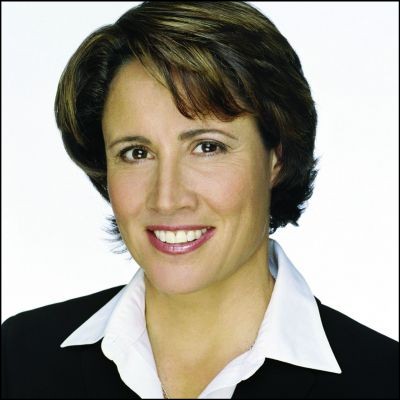Names in the Game: Mary Carillo
The Long Island Tennis Magazine Interview

Long Island Tennis Magazine book critic Brent Shearer recently had the opportunity to chat with noted tennis broadcaster, Mary Carillo, on topics ranging from the Agassi-Sampras feud during the Hit for Haiti benefit in Indian Wells, to how Venus and Serena Williams have dominated the women’s game. As ever, the Douglaston, Queens, N.Y. native spoke her mind with her customary blend of humor and optimism.
Carillo has covered tennis for ESPN, CBS, NBC and USA networks. She has been fixture at the Olympics working for both CBS and NBC, starting in 1992. In addition, she is a correspondent for HBO’s Real Sports with Bryant Gumbel. Together with veteran sportswriter Frank DeFord, Carillo won a Peabody Award for the HBO documentary “Dare to Compete: The Struggle of Women in Sports.”
Before asking Carillo some specific questions about the state of our game and the state of Mary C., Shearer pointed out that one way to look at her career is that she is following in the footsteps of that other great reporter from Queens, Jimmy Breslin. The “Breslin” technique is to talk to the least important person in the room. It also involves getting away from the pack of reporters and basing your stories on “real” people who may have been overlooked by other media outlets.
Carillo said she was honored to hear her work compared to Breslin’s. She acknowledged being impressed by such legendary stories from the master as the time after the Kennedy assassination, when Breslin interviewed John F. Kennedy’s gravedigger.
This influence, in part, explains Carillo’s penchant for finding unusual stories and adding color to sports broadcasts by talking to non-traditional sources.
Carillo, who turned 53, a day before this March 16 conversation with Long Island Tennis Magazine, talked about changes the game needs to make, Patrick McEnroe’s role as Davis Cup Captain and the effect of her children, 22-year-old Anthony and 18-year-old Rachel, on her life. She squeezed in the interview from her home in Naples, Fla., en route to her daughter Rachel’s high school tennis match.
Have your kids made it easier for you to communicate with the players on the tour?
I hope so. I have a great respect form young people. When you think about all these young people, and not only tennis players, but also the athletes I met at the Olympics, and you consider their level of commitment to reaching publicly-stated goals, you have to be impressed. I’m a big fan of these kids. They really show an uncommon poise.
And you can contrast this with what happened at the Hit for Haiti benefit where you had bad feelings between two veterans messing up the whole evening. It was really awkward and unpleasant between Agassi and Sampras. If you compare that with the way Rafa and Roger handled themselves, you have to admire the younger generation’s class and grace.
What was the biggest challenge the first time you did a non-tennis assignment?
It really didn’t feel awkward. I made it clear that the only sport I’m fluent in is tennis. I got a chance at CBS to interview the skiers at the bottom of the hill at the 1992 Winter Games in France. I just feel a deep comfort level doing the research, and I’m naturally curious so whether its skiing or gymnastics or table tennis, or doing Real Sports With Bryant Gumbel, it’s a lot of fun.
What tennis commentary team that you’ve been on had the best chemistry?
I think that working with John McEnroe and Ted Roberts has been pretty special. At first, I was just covering women’s tennis. When I started doing men’s, it was with Cliff Drysdale and Fred Stolle. I wanted to bring to these broadcasts what I thought I could deliver, but I also wanted to make sure it all blended. I didn’t want to step on anybody’s toes.
Is women’s tennis too loud? Is all the grunting unfair to opponents? How should it be fixed?
It’s a problem. Women’s tennis is too loud. When I hear that people cannot warm up to Maria Sharapova, I think that’s part of the problem. When Monica Seles grunted, I believed it was an organic part of her game. If it becomes just a tool for intimidation, it gets to be too much. Kids are being taught to make noise. I believe in doing hard things and making them look easy. It does give players an unfair advantage.
Is the reason the Williams Sisters have been able to dominate without being full-time tour players is that they just serve better than anybody else?
That’s a big part of it, but I think the one thing that has allowed them to stand apart is their mental fitness, especially in Serena’s case. In the past, the best female players, from Billie Jean King to Chris Evert to Steffi Graff to Monica Seles, were all mentally strong. Martina Hingis had it too, until people figured out they could break her serve. Justine Henin is the same. Plus she has so much variety in her game that she has a lot of options.
But most of the women, they’re incredibly fit and they’re taught to hit hard, but there’s a lot of choking and nerves that hold them back. Serena is really the last word in mental toughness, but for a lot of the top women, this is where they’re vulnerable.
The U.S. Davis Cup team just suffered a tough loss in Belgrade? Is Patrick McEnroe’s job in danger?
No, I think Patrick did a great job. He didn’t have Andy Roddick, so it was tough. I have a lot of admiration for what he’s done as Davis Cup coach. He earned the respect of Pete Sampras and Andre Agassi. He told the Bryan Brothers that they could own Saturdays (the doubles match, normally played on Saturday) and that’s worked out pretty well. We also haven’t seen James Blake play his best tennis at the Davis Cup so, overall, I don’t think you can fault Patrick.
You’ve been an outspoken opponent of on-court coaching. What is your take on the issue now?
I still think you have to teach the kids that it’s their responsibility to show up and play on their own. Obviously, there’s a lot of coaching going on despite the rules against it. You cannot have the chair umpire try to police it, they have to pay attention to what’s going on while on the court. You could station people in the player’s boxes. You’d have to use common sense in the trickier situations when coaching is going on, but the beauty of our game is that you are out there all alone and we should keep it that way. Part of that is teaching kids that they’re on their own.
Where do you draw the line in the use of sex to market WTA players? Are you happy with the current standards?
I feel some hesitation about putting these young women in fairly revealing, suggestive poses and positions. There is a lot of pressure from agents to market their players this way, but I think you have to be careful. In the past, tennis was, by far, the biggest women’s sport and its athletes were taken seriously. I don’t think we want to lose this.
 You’ve come a long way from hoisting the French Mixed Trophy with John McEnroe in 1977. What lessons have you learned covering the game?
You’ve come a long way from hoisting the French Mixed Trophy with John McEnroe in 1977. What lessons have you learned covering the game?
What I tell my kids is that it’s a big and a fascinating world out there, make sure you see as much of it as you can. I’ve been fortunate to have had a lot of great opportunities in covering tennis and other sports. I love to travel and see new people. Not everyone, for example, who was covering the Vancouver Olympics, would have jumped at the chance to go to the Arctic Circle. As long as I get to spend enough time with my family, I’m up for chasing stories. I’m just a really big respecter of athletes, and I love bringing their stories to people.






